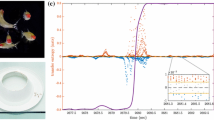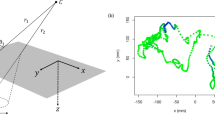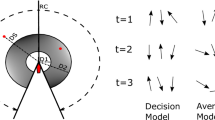Abstract
Recent experiments by Ward et al. have shown that fish a moving fish group detects hidden predators faster and more accurately than isolated individuals. The increase in speed, in particular, seems to be a consequence of the movement-mediated nature of the interactions used by fish to share information. The present work aims at investigating the link between movement and information transfer underlying collective decisions in fish. We define an individual-based self-propelled particle (SPP) model of the decision-making process analyzed by Ward et al. We fit it to data in order to deduce the smallest set of interaction rules consistent with the experimentally observed behaviour. We infer the relative weight of different social forces on fish movement during the decision-making process. We find that, in order to reproduce the observed experimental trends, both the social forces of alignment and attraction have to be introduced in the model, alignment playing a more important role than attraction. We finally apply this model to make theoretical predictions about fish ability to detect and avoid a moving predator in a natural environment such as open water.
Access this chapter
Tax calculation will be finalised at checkout
Purchases are for personal use only
Similar content being viewed by others
Notes
- 1.
This is chosen according to the fact that the predator replica used in [6] was 12 cm long.
References
Dall SRX, Giraldeau LA, Olsson O, McNamara JM, Stephens DW (2005) Information and its use by animals in evolutionary ecology. Trends Ecol Evol 20(4):187–193
King AJ, Cowlishaw G (2007) When to use social information: the advantage of large group size in individual decision making. Biol Lett 3(2):137–139
Couzin ID (2009) Collective cognition in animal groups. Trends Cogn Sci 13(1):36–43
Treherne J, Foster W (1980) The effects of group size on predator avoidance in a marine insect. Anim Behav 28(4):1119–1122
Lima SL (1995) Back to the basics of anti-predatory vigilance: the group-size effect. Anim Behav 49(1):11–20
Ward AJW, Herbert-Read JE, Sumpter DJT, Krause J (2011) Fast and accurate decisions through collective vigilance in fish shoals. Proc Natl Acad Sci USA 108(6):2312–2315
Sumpter D, Buhl J, Biro D, Couzin I (2008) Information transfer in moving animal groups. Theory Biosci 127(2):177–186
Sumpter DJT, Krause J, James R, Couzin ID, Ward AJW (2008) Consensus decision making by fish. Curr Biol 18(22):1773–1777
Ward AJW, Sumpter DJT, Couzin ID, Hart PJB, Krause J (2008) Quorum decision-making facilitates information transfer in fish shoals. Proc Natl Acad Sci USA 105(19):6948–6953
Vicsek T, András Czirók EBJ, Cohen I (1995) Novel type of phase transition in a system of self-driven particles. Phys Rev Lett 75:1226
Czirók A, Vicsek T (2000) Collective behavior of interacting self-propelled particles. Physica A 281:17–29
Czirok A, Barabasi A, Vicsek T (1999) Collective motion of self-propelled particles: kinetic phase transition in one dimension. Phys Rev Lett 82(1):209–212
Couzin ID, Krause J, James R, Ruxton GD, Franks NR (2002) Collective memory and spatial sorting in animal groups. J Theor Biol 218(1):1–11
Vicsek T, Zafeiris A (2012) Collective motion. Phys Rep. doi:10.1016/j.physrep.2012.03.004
Mann RP (2011) Bayesian inference for identifying interaction rules in moving animal groups. PLoS ONE 6(8):e22827
Strombom D (2011) Collective motion from local attraction. J Theor Biol 283(1):145–151
Rountree RA, Sedberry GR (2009) A theoretical model of shoaling behavior based on a consideration of patterns of overlap among the visual fields of individual members. Acta Ethol 12(2):61–70
Herbert-Read JE, Perna A, Mann RP, Schaerf TM, Sumpter DJT, Ward AJW (2011) Inferring the rules of interaction of shoaling fish. Proc Natl Acad Sci USA 108(46):18726–18731
Radakov D (1973) Schooling in the ecology of fish. Wiley, New York
Romey WL (1996) Individual differences make a difference in the trajectories of simulated schools of fish. Ecol Model 92(1):65–77
Lemasson B, Anderson J, Goodwin R (2009) Collective motion in animal groups from a neurobiological perspective: the adaptive benefits of dynamic sensory loads and selective attention. J Theor Biol 261(4):501–510
Moussaïd M, Guillot EG, Moreau M, Fehrenbach J, Chabiron O, Lemercier S, Pettré J, Appert-Rolland C, Degond P, Theraulaz G (2012) Traffic instabilities in self-organized pedestrian crowds. PLoS Comput Biol 8(3):e1002442
Hemelrijk CK, Hildenbrandt H, Reinders J, Stamhuis EJ (2010) Emergence of oblong school shape: models and empirical data of fish. Ethology 116(11):1099–1112
Author information
Authors and Affiliations
Editor information
Editors and Affiliations
Rights and permissions
Copyright information
© 2013 Springer International Publishing Switzerland
About this paper
Cite this paper
Bottinelli, A., Perna, A., Ward, A., Sumpter, D. (2013). How Do Fish Use the Movement of Other Fish to Make Decisions?. In: Gilbert, T., Kirkilionis, M., Nicolis, G. (eds) Proceedings of the European Conference on Complex Systems 2012. Springer Proceedings in Complexity. Springer, Cham. https://doi.org/10.1007/978-3-319-00395-5_73
Download citation
DOI: https://doi.org/10.1007/978-3-319-00395-5_73
Publisher Name: Springer, Cham
Print ISBN: 978-3-319-00394-8
Online ISBN: 978-3-319-00395-5
eBook Packages: Physics and AstronomyPhysics and Astronomy (R0)




